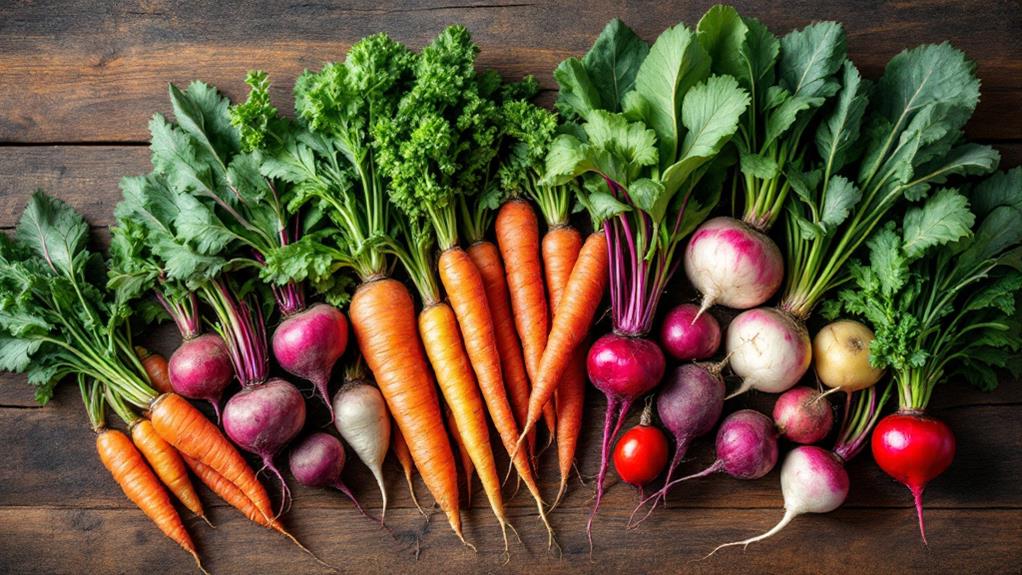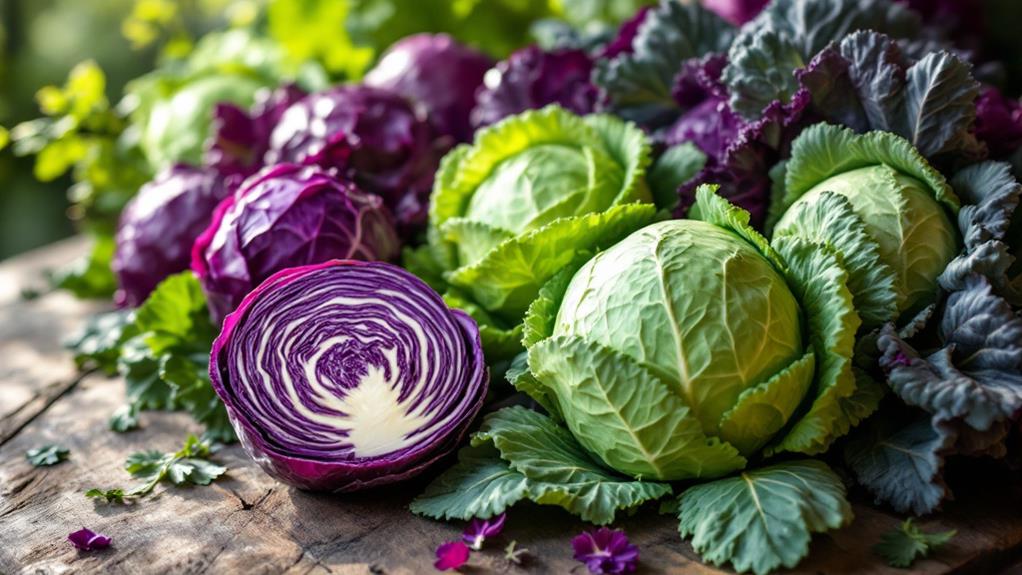The Ultimate Guide to the Different Types of Vegetables

You're about to investigate the colorful world of vegetables, where each type offers unique flavors and nutritional benefits. Leafy greens like spinach and kale enhance iron and antioxidants, perfect for improving your meal's health quotient. Root vegetables such as carrots and beets provide fiber and carbs, supporting a balanced diet. Bulbs like garlic pack a flavorful punch with antibacterial properties, while stems like asparagus add crunch and nutrients. The variety in your vegetable choices not only supports health but also promotes biodiversity. Uncover how different cooking methods can optimize flavor and nutritional content in this comprehensive manual.
Understanding Vegetable Classifications
When you investigate the world of vegetables, understanding their classifications can boost your appreciation and usage of them in daily cooking. With a wide variety of vegetables available, knowing how they're categorized helps you tap into their specific nutritional benefits. For instance, root vegetables, like carrots and beets, are a powerhouse of complex carbohydrates and fiber. These nutrients are vital for maintaining energy levels and promoting digestive health, making root vegetables a fantastic enhancement to your meals.
Understanding the classification of vegetables isn't just about knowing their names; it's about recognizing their unique contributions to your diet. While root vegetables are celebrated for their energy-boosting properties, other categories such as bulb and stem vegetables offer different benefits. Each type serves its own purpose, which is why it's significant to diversify the vegetables you consume regularly.
Moreover, exploring lesser-known varieties among the thousands of vegetables available can improve your culinary repertoire. This not only introduces new flavors to your dishes but also supports biodiversity. By incorporating a diverse range of vegetables into your cooking, you guarantee a balanced intake of nutrients and participate in conservation efforts that sustain rare vegetable species for future generations.
Popular Leafy Greens
Leafy greens are the lively powerhouses of the vegetable world, delivering a burst of nutrients essential for maintaining a balanced diet. You'll find these colorful veggies, like spinach, kale, collard greens, chard, and arugula, packed with important vitamins and minerals. Spinach, for instance, is a fantastic source of iron, vital for producing red blood cells. Kale stands out with its high antioxidant content, which supports overall health and helps prevent diseases.
Collard greens, a Southern cuisine staple, offer impressive amounts of vitamins K and A. These nutrients are key for maintaining healthy bones and good vision. Don't overlook Swiss chard, with its colorful stems. It's rich in magnesium, potassium, and vitamin C, crucial for promoting cardiovascular health and ensuring proper muscle function.
Arugula, often tossed in salads, is low in calories but high in antioxidants. This makes it an excellent choice if you're watching your weight or aiming to reduce inflammation. By incorporating these leafy greens into your diet, you're not just adding flavor and texture to your meals, but also reaping numerous health benefits. So, go ahead and enjoy the lively world of leafy greens!
Exploring Root Varieties

Beneath the soil's surface lies the hidden bounty of root vegetables, offering a wealth of nutrition and flavor. These underground gems are an integral part of your diet, packed with complex carbohydrates and fiber. Root vegetables like potatoes, carrots, beetroots, radishes, and sweet potatoes each bring unique flavors and health benefits to the table.
Carrots, for instance, are loaded with beta-carotene, a vital nutrient for maintaining good eye health. Your body converts this into vitamin A, fundamental for vision. Beetroots, with their striking red hue, are rich in antioxidants. These nutrients can help reduce inflammation and improve blood flow, potentially reducing the risk of numerous health issues.
These adaptable vegetables can be enjoyed in multiple ways. Consider roasting them to improve their natural sweetness, boiling them for a softer texture, or mashing for a comforting dish. By incorporating root vegetables into your meals, you not only savor their unique flavors but also elevate your nutritional intake.
Embrace the variety of root vegetables in your cooking. Their rich flavors and health benefits make them a worthwhile enhancement to any diet, helping you maintain a balanced and nutritious lifestyle.
Unique Bulb and Stem Options
Root vegetables provide a strong foundation for a balanced diet, but don't overlook the colorful possibilities offered by bulb and stem vegetables. Bulb vegetables like onions and garlic pack a punch with their bold flavors and impressive health benefits. Garlic, for instance, is renowned for its antibacterial properties, making it a powerhouse supplement to your meals. Onions, another popular bulb vegetable, are rich in antioxidants that can improve your dish's flavor and your health.
Fennel stands out as a unique bulb vegetable with its distinct anise flavor. It's not just tasty; it's also packed with fiber and vitamin C, making it a great choice for salads and soups when you're aiming for both flavor and nutrition.
On the other hand, stem vegetables like asparagus and celery bring a delightful crunch to your table. They're high in vital nutrients, such as dietary fiber and vitamin K, contributing considerably to a balanced diet. If you enjoy them raw or cooked, these stem vegetables offer versatility in meal preparation, allowing you to experiment with flavors while reaping considerable health benefits. Welcome these options to boost your culinary adventures and well-being.
Nutritional Benefits and Cooking Tips

Regarding vegetables, a rich selection offers not only a burst of flavors but also vital nutritional benefits. Leafy greens like spinach and kale are packed with vitamins A, C, K, folate, iron, and calcium. These vegetables provide a powerhouse of nutrients necessary for maintaining general health. When you incorporate these into your diet, you're not just enjoying a tasty meal but also improving your immune system and bone health.
Root vegetables, including carrots and sweet potatoes, are excellent sources of complex carbohydrates and fiber. They're particularly beneficial for eye health due to the beta-carotene present in carrots. You can enjoy these cooked in different ways, such as roasting or steaming, to preserve their nutrient content.
Bulb vegetables like garlic and onions bring strong flavors and health benefits, with garlic boasting antibacterial properties. Adding them to your dishes can improve both taste and well-being.
For stem vegetables, such as asparagus and celery, steaming or sautéing helps retain their crunchy texture and vitamin K content. Remember, fruits and vegetables like broccoli and cauliflower are low in calories but rich in fiber, vitamins, and antioxidants, making them perfect for a nutritious diet.




